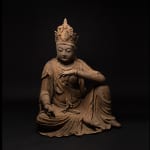Ming Wooden seated Guanyin in relaxed posture, 11th Century CE - 17th Century CE
Wood
115.6 x 99.1 cm
45 1/2 x 39 1/8 in
45 1/2 x 39 1/8 in
HK.2045
Further images
-
(View a larger image of thumbnail 1
)

-
(View a larger image of thumbnail 2
)

-
(View a larger image of thumbnail 3
)

-
(View a larger image of thumbnail 4
)

-
(View a larger image of thumbnail 5
)

-
(View a larger image of thumbnail 6
)

-
(View a larger image of thumbnail 7
)

-
(View a larger image of thumbnail 8
)

-
(View a larger image of thumbnail 9
)

-
(View a larger image of thumbnail 10
)

This is a wooden sculpture of Avalokiteshvara in Water Moon Form from Ming period. Here, Avalokiteshvara appears meditative and relaxed, seated informally in the “royal-ease” posture. Ornately dressed, with silk...
This is a wooden sculpture of Avalokiteshvara in Water Moon Form from Ming period. Here, Avalokiteshvara appears meditative and relaxed, seated informally in the “royal-ease” posture. Ornately dressed, with silk robes, fluttering sashes, jewelry, and an elaborate hairstyle, he also wears a headpiece that features an image of Amitabha, the buddha to whom Avalokiteshvara attends.
Of the many manifestations of the bodhisattva Avalokiteshvara, perhaps none was more prevalent in East Asia than the uniquely Chinese form known as “Water-Moon Avalokiteshvara,” which later also spread to Korea and Japan. This form of the bodhisattva presides over his own paradise, Potolaka, which is described in scripture as a rugged seaside cave from which Avalokiteshvara could admire the reflection of the moon in the water. Believers might look to a sculpture like this as a guide for their own journeys toward enlightenment.
Wooden statues with painted surfaces were made in large numbers for Buddhist temples in north China during the 11th-17th centuries. They originally sat in a temple hall, along with other Buddhist figures of veneration. Many northern temples were as extensive as palaces, and contained a series of courtyards in which stood magnificent buildings devoted to worship, teaching and monks’ living quarters. Water Moon Guanyins with attendants were often placed back-to-back with the main Buddha image in an image hall, facing the rear, that lead into a further courtyard. Thus they protected the sanctified domain against evil spirits.
Of the many manifestations of the bodhisattva Avalokiteshvara, perhaps none was more prevalent in East Asia than the uniquely Chinese form known as “Water-Moon Avalokiteshvara,” which later also spread to Korea and Japan. This form of the bodhisattva presides over his own paradise, Potolaka, which is described in scripture as a rugged seaside cave from which Avalokiteshvara could admire the reflection of the moon in the water. Believers might look to a sculpture like this as a guide for their own journeys toward enlightenment.
Wooden statues with painted surfaces were made in large numbers for Buddhist temples in north China during the 11th-17th centuries. They originally sat in a temple hall, along with other Buddhist figures of veneration. Many northern temples were as extensive as palaces, and contained a series of courtyards in which stood magnificent buildings devoted to worship, teaching and monks’ living quarters. Water Moon Guanyins with attendants were often placed back-to-back with the main Buddha image in an image hall, facing the rear, that lead into a further courtyard. Thus they protected the sanctified domain against evil spirits.









